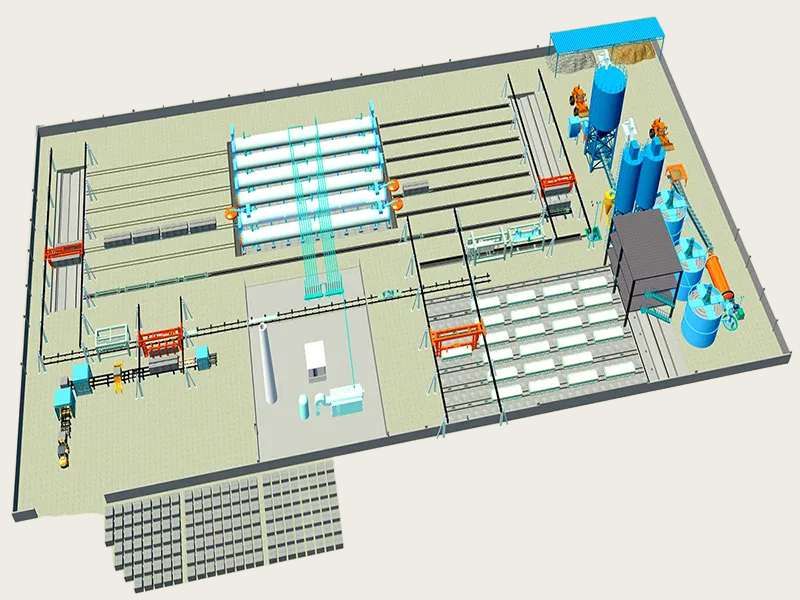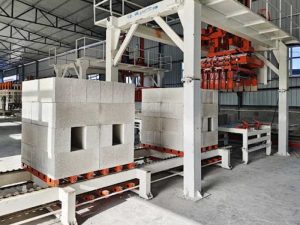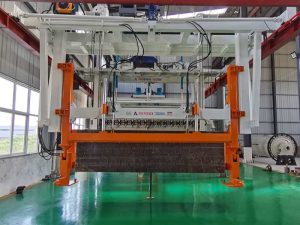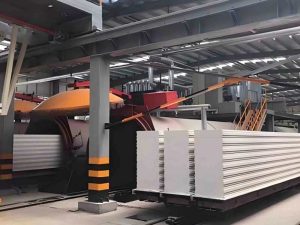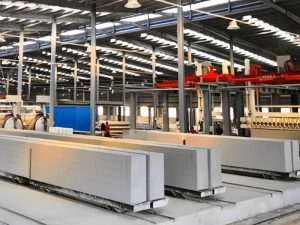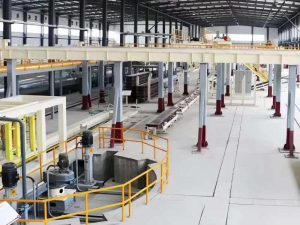150,000 m3/Year AAC Block Plant Manufacturer
The 150,000 m³/Year AAC Block Plant is a large-scale production line. It makes Autoclaved Aerated Concrete (AAC) blocks, with an annual output of 150,000 m³. It is for building materials enterprises, prefabricated component factories and large construction material bases.
Our plant can be customized based on your needs. Its main equipment includes raw material batching system, mixing-pouring machine, cutting machine, autoclave, conveying system, etc.
The plant can make standard AAC blocks. It can also process AAC panels, lintels and floor slabs. These products are widely used in residential, commercial and industrial buildings. They are used for walls, partitions and floors. They have advantages like light weight, thermal insulation, sound insulation and fire resistance.
- Capacity: 150,000m3/year
- Type: Fully automatic
150,000 m3/Year AAC Block Plant Price
The total price of 150,000 m3/Year AAC Block Plant ranges from $1,000,000 to $1,6 00,000 (excluding land costs). It includes:
Core equipment (jaw crusher, ball mill, slurry tanks, casting line, tilting cutter, autoclaves): $750,000 to $950,000
Installation, commissioning, and technical training: $100,000 to $150,000.
Auxiliary systems (dust removal, wastewater recovery): $80,000 to $120,000.
Spare parts and initial raw material reserves: $50,000 to $80,000.
We offer flexible payment plans and localized cost optimization to ensure high cost-effectiveness.
Advantages of 150,000 m3/Year AAC Block Plant
- High Efficiency & Stable Output
Annual output of 150,000 m³ meets large-scale needs. Integrated equipment and smooth conveying reduce manual work, ensuring stable production. - Great Quality & Strong Adaptability
Our 150,000 m3/Year AAC Block Plant uses precision cutting machines and autoclaves to produce aerated concrete products (blocks, slabs, lintels) with uniform size and stable performance (lightweight, thermal insulation, sound insulation, and fire resistance). Products can also be customized according to different construction scenarios. - Cost-Effective
Automation reduces labor costs. Recycling of Wastewater and dust reduces raw material and environmental costs. Flexible packages and maintenance discounts lower investment and operational risks. - Eco-Friendly & Compliant
A full set of environmental protection equipment (dust removal, wastewater recovery) can effectively control emissions and comply with global environmental protection policies. - Comprehensive After-Sales Support
Including installation, commissioning, and training, we help you quickly master operation. Timely spare parts and rapid fault response ensure long-term and efficient operation of the equipment.
150,000 m3/Year AAC Block Plant Process
Raw material process → Batching and Mixing → Pouring → Static pre-curing → Cutting → Autoclaving Curing → Finished product Processing
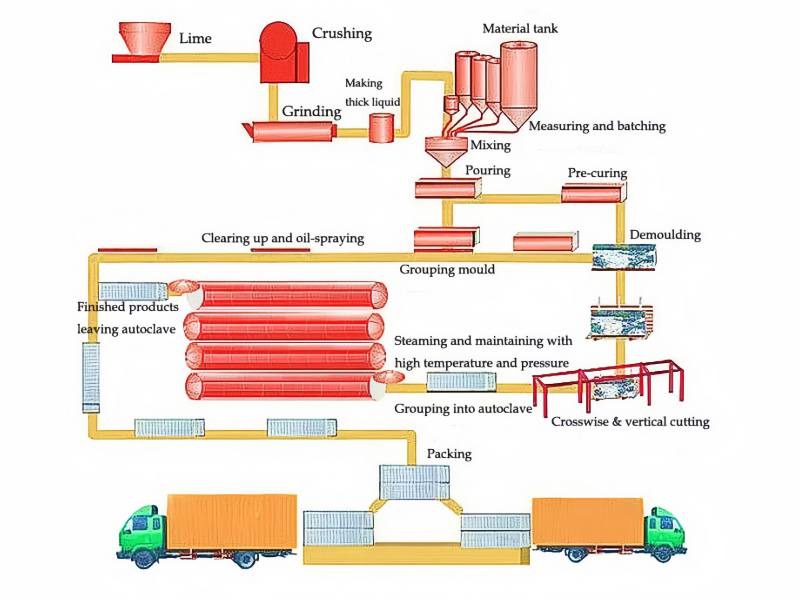
1. Raw Material Processing: Sand is crushed and ground to the desired fineness. Cement, lime, and gypsum are stored in silos, and aluminum powder is mixed with water to form an aluminum slurry.
2. Batching and Mixing: The various raw materials are weighed according to precise proportions and then thoroughly mixed in a mixer to form a uniform slurry.
3. Pouring: The mixed slurry is poured into steel molds. The size and shape of the molds can be designed to meet the desired block specifications.
4. Static Pre-curing: The molds containing the slurry are transported to a pre-curing area where the slurry gradually hardens under suitable temperature and humidity conditions to achieve initial strength. This process typically takes several hours.
5. Cutting: After the slurry is pre-cured, it is cut into the desired size and shape using high-precision cutting equipment like steel wire or blades.
6. Autoclave Curing: Blocks are placed in an autoclave and cured for several hours at temperatures of 175-200°C and pressures of 10-15 bar, significantly enhancing the blocks’ strength and durability.
7. Finished Product Processing: After autoclave curing, the blocks are removed from the autoclave and transported to a storage area. After inspection and packaging, they are ready for shipment.
Raw Materials of AAC block

- Cement (Portland Cement): Acts as a primary binder, providing strength and durability to the blocks. Typically, 43 or 53-grade OPC is used.
- Fly Ash or Sand: Serves as the main siliceous material. Fly ash, a byproduct of coal-fired power plants, is an eco-friendly alternative to sand, providing the necessary silica content.
- Lime: A key calcareous material that reacts with other components to form the binding matrix and contributes to the chemical reactions during production.
- Gypsum: Added in small quantities to regulate the setting time and improve the workability of the mix.
- Aluminum Powder or Paste: Functions as a foaming agent. It reacts with lime and water to produce hydrogen gas, creating the characteristic porous, lightweight structure.
- Water: Essential for the hydration of cement and lime, and to facilitate the chemical reactions necessary for the setting and hardening of the blocks.
These materials are carefully proportioned and mixed to form a slurry, which is then cast, pre-cured, cut, and finally autoclaved to produce the finished AAC blocks.
Main Equipment in 150,000 m3/Year AAC Block Line
1. Jaw Crusher
Function: Crushes large lumps of raw materials such as limestone and gypsum into 50-150 mm pieces, facilitating subsequent fine grinding. It is a key piece of equipment for raw material pretreatment.
Structure: A fixed jaw plate and a movable jaw plate form a deep-chamber crushing chamber lined with impact-resistant, replaceable high-manganese steel tooth plates.
Capacity Range: Common models range from 100 to 500 t/h. The motor and main unit are integrated on a steel frame base, occupying only 4-6 m² of floor space.
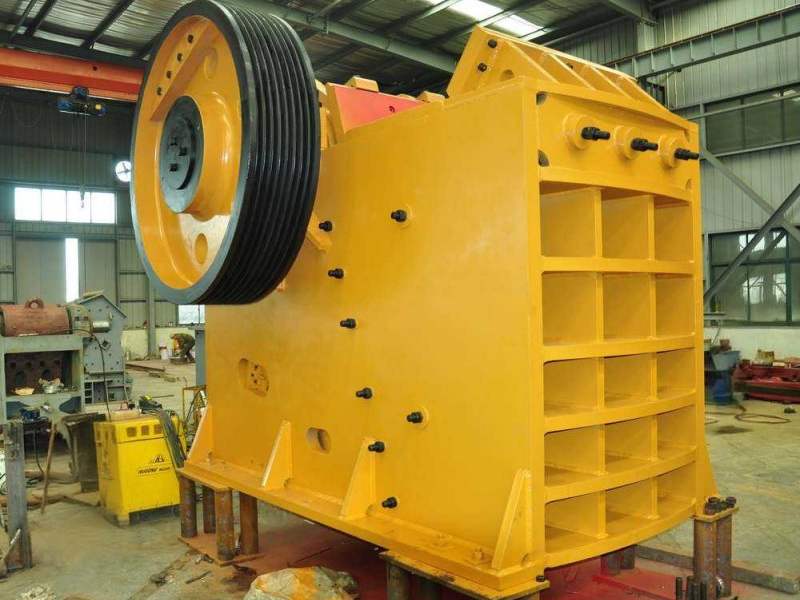
2. Ball Mill
Function: Grinds crushed lime, sand, or fly ash into a fine powder with a mesh size of 80-400 (0.2-0.045 mm) to enhance reactivity.
Structure: Horizontal cylinder+wear-resistant liner+steel ball media. It driven by a motor, reducer, and large gear.
Key Parameters: Cylinder diameter 1.2-2.4 m, ball load 5-30 t, power 55-800 kW.
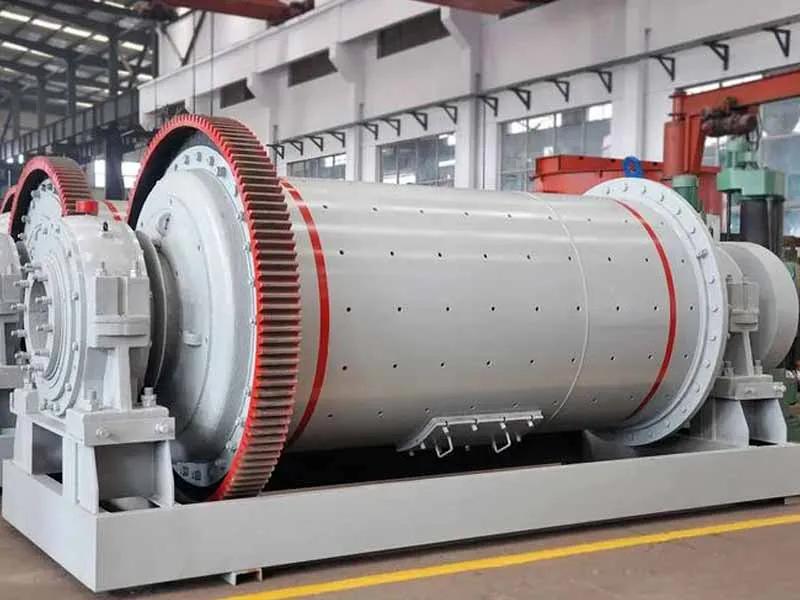
3. Batching System
Function: Accurately weighs cement, lime, fly ash, aluminum powder, and water according to the recipe, with an error of ≤ ±0.5%. Equipped with multiple silos, metering, and conveying equipment.
Module components: Electronic scale, screw feeder, pneumatic butterfly valve, PLC touch screen; one-touch recipe call, batching completed within 30 seconds.
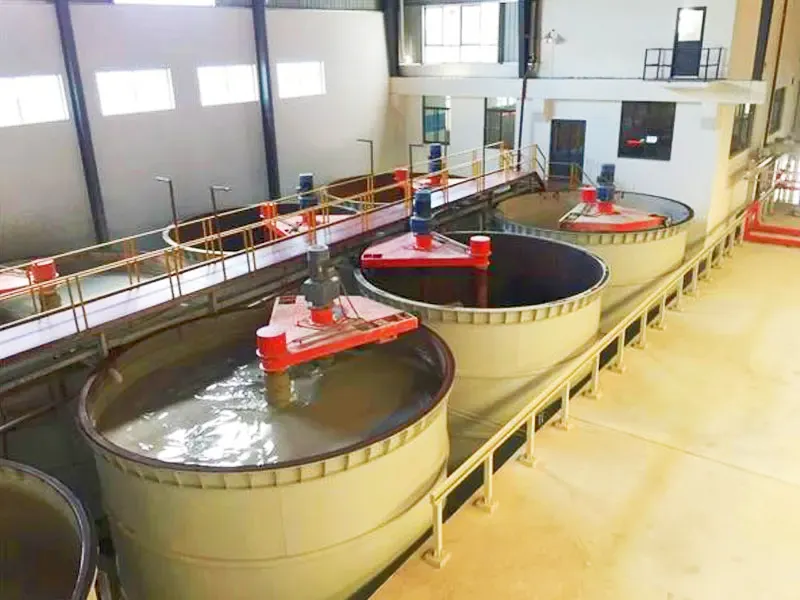
4. Mixing & Casting Machine
Function: Rapidly mixes weighed dry materials with water and aluminum powder into a fluid slurry, which is then poured into a mold for foaming.
Features: Twin-shaft forced mixing completes one batch in 60-90 seconds; hydraulically tilts 90° for drip-free pouring.
Key Parameters: Effective volume 2-4 m³, motor power 37-55 kW, removable mixing blades, wear life ≥ 30,000 cycles.
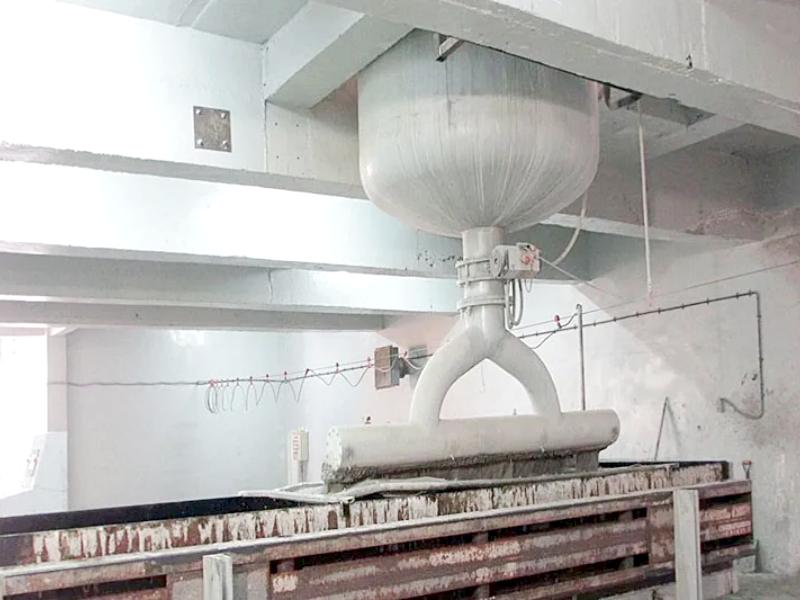
5. Tilting Cutter
Function: Cuts pre-cured billets into desired specifications with an accuracy of ±1 mm. Offcuts are recycled online.
Structure: Three sets of longitudinal, transverse, and horizontal steel wire frames; servo motors synchronize lifting and lowering, automatically compensating for wire wear.
Capacity: Cutting cycle ≤ 5 minutes/die; can cut 75-300 mm thickness, 600 mm standard length, or 1200 mm slabs.

6. Autoclave
Function: High-temperature, high-pressure steam curing allows the green body to complete the hydrothermal synthesis reaction within 8 hours, increasing its strength by 5-8 times.
Specifications: Φ2.68×32 m or Φ2.85×38 m; design pressure 1.6 MPa, operating temperature 200°C; equipped with safety interlock and automatic blowdown.
Configuration: Each medium-sized line is equipped with 4-8 units, which can be connected in series or parallel. Energy-saving models include a waste heat recovery interface.
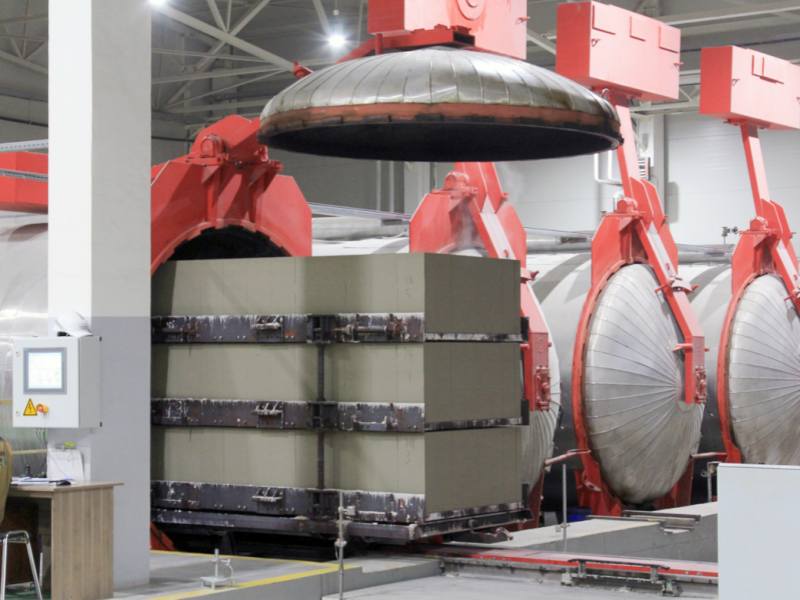
7. PLC Control Room
Function: Serves as the control center for the entire production line, offering features such as recipe management, parameter adjustment, process monitoring, energy consumption analysis, fault alarms, and remote app viewing.
Hardware: Reserved OPC UA interface for integration with the factory’s MES/ERP system.

8. Waste Gas Heat Recovery System
Principle: Autoclave exhaust gas at 160°C is preheated to 90°C via a heat exchanger, saving 8–12% of natural gas annually.
Configuration: Plate heat exchanger+circulation pump+automatic temperature control valve.

Main Parameters of 150,000 m³ AAC Block Plant
| Parameter Category | Specific Item | Detailed Description |
| 1. Production Capacity | Annual Output | 150,000 m³ (based on standard 8-hour working day, 300 working days/year) |
| Daily Output | About 500 m³ (theoretical value, adjustable according to actual production schedule) | |
| Hourly Output | About 62.5 m³ (for core forming process) | |
| 2. Raw Material Requirements | Main Raw Materials | Fly ash (or sand), cement, lime, aluminum powder, water (compliant with industrial water standards) |
| Raw Material Consumption | Approximately 300-350 kg of dry raw materials per cubic meter of AAC block (varies by product density) | |
| 3. Core Equipment Specifications | Batching System | Capacity 5-8 m³/h, accuracy ±1% (for raw material proportioning) |
| Mixing-Pouring Machine | Mixing capacity 3-5 m³/batch, pouring speed 2-3 minutes/batch | |
| Cutting Machine | Cutting accuracy ±1 mm (for block size Applicable to max block size 600×240×200 mm) | |
| Autoclave | Diameter 2-2.5 m, length 20-25 m. Working pressure 1.2-1.5 MPa, working temperature 190-210℃ | |
| 4. Product Specifications | Product Type | AAC blocks, AAC panels, AAC lintels (customizable) |
| Block Density | Common grades: A3.5 (≤350 kg/m³), A5.0 (≤500 kg/m³) | |
| Standard Block Size | 600×200×100 mm, 600×240×100 mm (other sizes customizable via cutting machine) | |
| 5. Energy & Utility Consumption | Power Consumption | About 80-100 kWh per cubic meter of AAC product |
| Steam Consumption | About 200-250 kg of steam per cubic meter of AAC product (for autoclaving process) | |
| Water Consumption | About 150-200 L per cubic meter of AAC product (recyclable via wastewater system) | |
| 6. Workshop & Land Requirement | Total Land Area | Approximately 15,000-20,000 m² (including production workshop, raw material warehouse, finished product yard) |
| Production Workshop Area | About 8,000-12,000 m² (for equipment layout and production flow) | |
| Warehouse Area | Raw material warehouse (3,000-4,000 m²), finished product yard (4,000-5,000 m²) |
What Is An AAC Block?

Autoclaved aerated concrete (AAC) blocks are a lightweight, porous, high-strength new building material.
The unique internal pore structure provides lightweight, high strength, thermal insulation, fire resistance, and sound insulation.
It is an ideal choice for achieving energy-saving and structural safety in buildings.
Application of AAC Block
Civil Buildings: Used in internal and external walls, floor slabs, roof slabs, etc. of residential buildings to reduce building weight and improve seismic performance.
Commercial Buildings: Suitable for non-load-bearing walls of shopping malls, hotels, office buildings, etc., with good thermal insulation and sound insulation effects to enhance building comfort.
Industrial Buildings: Served as wall and partition materials for factories and warehouses, meeting the special requirements of industrial production for building materials.
Special Buildings: Widely applied in hospitals, schools, gymnasiums and other places due to their excellent fire resistance and environmental protection properties.
Services We Offer
- Project Planning & Design
Provide overall planning and detailed design schemes for AAC block plants based on client needs and actual conditions, including process design, equipment layout, and civil engineering design. - Equipment Supply & Installation
Supply full sets of AAC production line equipment, and undertake installation and commissioning to ensure normal operation, meeting designed capacity and product quality standards. - Technical Training
Offer professional training for operators, technicians, and managers covering production processes, equipment operation, maintenance, and quality management. - After-Sales Service
Establish a sound after-sales system providing daily maintenance guidance, fault troubleshooting, and spare parts supply to ensure continuous stable production. - Technical Support & Upgrades
Provide ongoing technical support and offer equipment upgrading/technical transformation solutions based on client needs and industry trends to improve efficiency and quality. - EPC General Contracting
One-stop EPC services from design, equipment procurement, civil construction, installation, and training to trial production for a hassle-free experience.
Other Hot-sale Block Manufacturing Plant
| Annual Production | Price (USD) | Core Configuration |
|---|---|---|
| 100,000 m³ | 1.5–1.9 M | Air-turning cutting, 3×31 m autoclaves |
| 150,000 m³ | 2.1–2.6 M | Robotic palletizing, 4×31 m autoclaves |
| 200,000 m³ | 2.8–3.5 M | Six-sided cutting, 4×37 m autoclaves |
| 300,000 m³ | 4.0–4.8 M | Dual cutting lines, 6×37 m autoclaves |
| 400,000 m³ | 5.5–6.5 M | Fully automatic air-turning, 8×37 m and above autoclaves |
